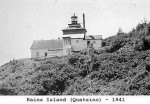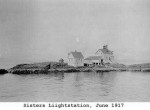If you do not know what Mise Tales is then please see Mise Tales One.
One or two things have come to mind. A friend wrote and asked if I had ever heard such and such a story about a crazy lighthouse keeper who killed himself.
Reading his story brought to mind another story that I had heard or read about at one time, but a Google search cannot seem to find any reference to either one.
Anyways, here are the two stories about crazy lighthouse keepers. If anyone can help in locating the source, or more information, please contact me.
****************************
Tale Number One from my friend.
Bob says:
I was again browsing your multi-faceted site and got to wondering if you had ever chanced on the story of a supposed suicide wherein a keeper bludgeoned himself to death by repeatedly running headfirst into a brick/stone/concrete wall?
The instance as it was told to me almost fifty (50) years ago was that a headkeeper on an unnamed light on the Pacific Coast went mad and performed the terminal skull-smashing in the presence of his assistant keeper.
It was related that the assistant keeper was a recent immigrant from Eastern European background with very little English language capabilities and who, by dint of his Eastern Bloc Soviet state upbringing, was also very fearful of any form of police or military authority. Continue reading Mise Tales Three →








